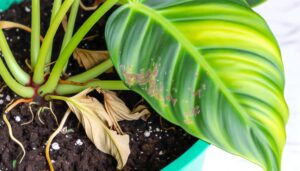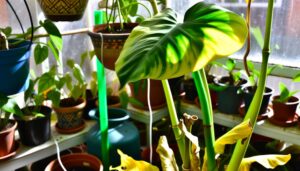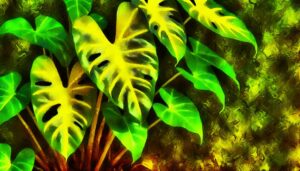What Are the Characteristics of a Baby Philodendron Splendid?
A Baby Philodendron Splendid exhibits heart-shaped, velvety leaves with a glossy green sheen. The leaves feature prominent venation, with robust primary veins and symmetrical secondary veins, creating a reticulate pattern.
Young leaves often display a reddish or bronze tint due to anthocyanins, gradually shifting to vibrant green. Typically, leaf sizes range from 4 to 6 inches, influenced by environmental conditions.
This plant prefers indirect sunlight, consistent moisture, and well-draining soil rich in organic matter. Maintaining ideal temperatures between 65-80°F and humidity levels of 60-80% is essential.
Additional, more detailed care insights can be discovered further.
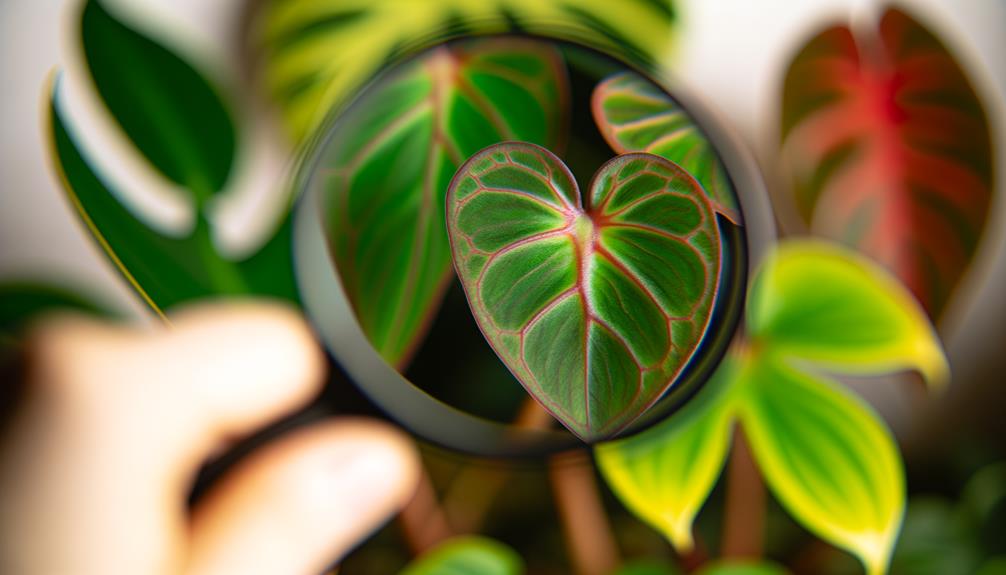
Key Takeaways
- Heart-shaped leaves with a slight gloss and dense trichomes.
- Young leaves exhibit a reddish or bronze tint, turning vibrant green as they mature.
- Robust primary veins with symmetrical branching of secondary veins in a reticulate pattern.
- Average leaf size ranges from 4 to 6 inches, influenced by environmental conditions.
- Thrives in indirect sunlight and requires consistent soil moisture for optimal growth.
Leaf Shape
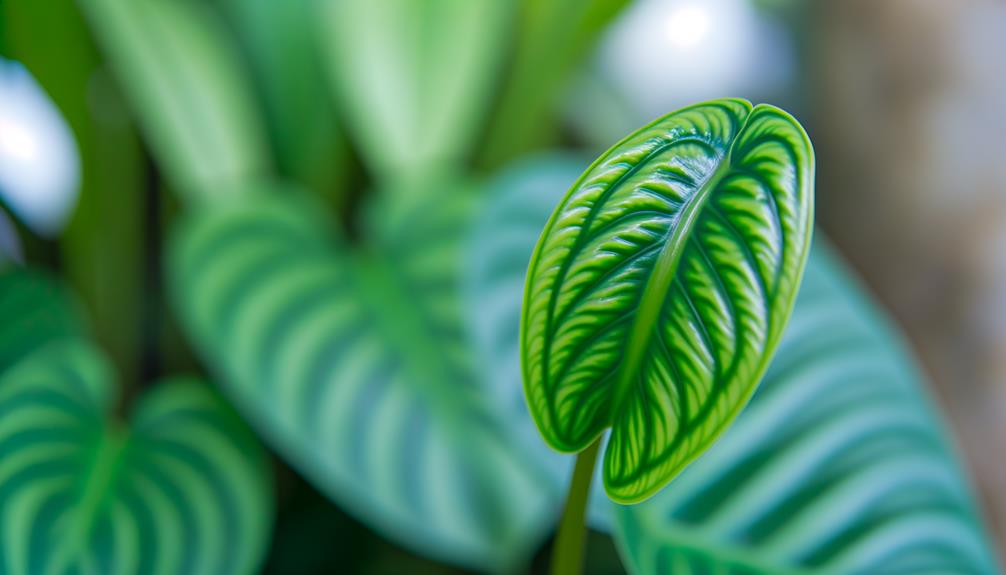
The leaves of a baby Philodendron Splendid are typically heart-shaped, exhibiting a prominent venation pattern that is characteristic of this species. These leaves feature a well-defined midrib from which secondary veins radiate, creating an intricate network.
This venation pattern not only enhances the leaf's structural integrity but also facilitates efficient nutrient transport. The leaves are generally smooth with a slight gloss, contributing to their aesthetic appeal. Margins are entire, meaning they lack serrations or lobes, which is a distinguishing feature among various Philodendron species.
The petiole, or leaf stalk, is relatively short in juvenile plants, ensuring the leaves remain close to the central stem, optimizing light capture essential for photosynthesis. This leaf morphology is critical for the plant's early development.
Color Variations
Beyond their distinct shape, the leaves of a baby Philodendron Splendid exhibit a range of color variations that contribute to their unique visual appeal. Initially, the leaves often emerge with a reddish or bronze tint, gradually evolving to a vibrant green as they mature.
This dynamic color shift is attributed to the varying levels of chlorophyll and anthocyanins present in the leaf tissues. The young leaves may display a subtle gradient, enhancing their aesthetic complexity. Additionally, the veins are prominently marked with a lighter hue, often appearing as delicate white or light green lines against the darker backdrop of the leaf surface.
These intricate color variations not only enhance the plant's ornamental value but also indicate its health and essentiality.
Leaf Texture
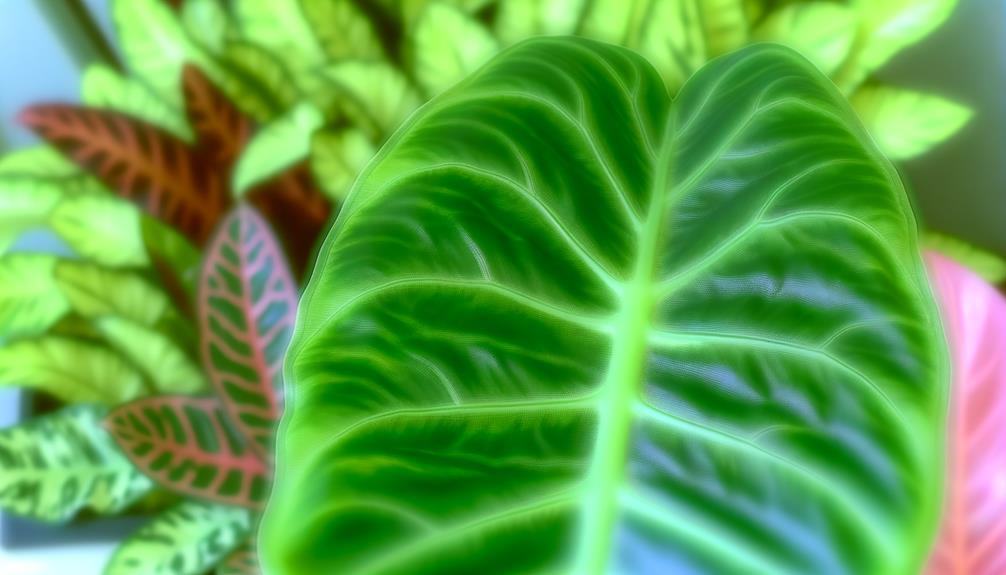
The leaf texture of a baby Philodendron Splendid exhibits notable characteristics, prominently featuring a velvety soft feel that enhances its tactile appeal.
This unique texture is coupled with a glossy green sheen, which not only contributes to its aesthetic allure but also indicates a healthy, thriving plant.
These dual attributes of velvety softness and glossy sheen underscore the plant's distinctive foliage qualities, making it a desirable specimen for enthusiasts and collectors.
Velvety Soft Feel
Characterized by their velvety soft texture, the leaves of a baby Philodendron Splendid exhibit a tactile quality that is both unique and alluring.
This distinct texture arises from a dense covering of fine trichomes, which are microscopic hair-like structures on the leaf surface.
These trichomes not only provide the characteristic softness but also play a role in reducing water loss by trapping a layer of air close to the leaf surface.
The velvety feel serves as an adaptive mechanism, enhancing the plant's ability to thrive in its native humid environments.
This attribute adds a sensory dimension to the plant, making it a coveted specimen for both botanical enthusiasts and interior plant decorators seeking to infuse spaces with textural diversity.
Glossy Green Sheen
In addition to their velvety softness, the leaves of a baby Philodendron Splendid exhibit a glossy green sheen, a trait that enhances their visual appeal and indicates healthy chlorophyll levels. This glossy texture is attributed to the cuticle layer on the leaves, which reflects light and helps in reducing water loss. The sheen is a sign of excellent plant health, suggesting adequate hydration and nutrient uptake. The following table outlines key attributes related to the glossy green sheen:
| Attribute | Description | Importance |
|---|---|---|
| Glossy Texture | Reflective, shiny surface | Visual appeal, health sign |
| Chlorophyll Levels | High concentrations | Indicates healthy leaves |
| Cuticle Layer | Protective, waxy coating | Reduces water loss |
| Light Reflection | Enhances leaf brightness | Aesthetic enhancement |
Understanding these characteristics aids in recognizing and promoting plant health.
Veining Patterns
Examining the veining patterns of a baby Philodendron Splendid reveals intricately structured veins that are both aesthetically pleasing and functionally significant. The primary veins are robust and well-defined, creating a visually striking contrast against the glossy green leaf surface.
Secondary veins branch off symmetrically, forming a reticulate pattern that aids in ideal nutrient and water distribution throughout the leaf blade. This veining architecture not only enhances the plant's ornamental value but also supports its physiological health by maximizing photosynthetic efficiency.
The leaf veins exhibit a lighter coloration compared to the dark green foliage, contributing to the overall allure of the plant. This detailed veining pattern is a key characteristic that distinguishes Philodendron Splendid from other species.
Size and Growth Rate

The baby Philodendron Splendid typically exhibits a moderate growth rate, with leaves reaching an average size of 4 to 6 inches in length during its juvenile stage. This growth rate is influenced by several factors, including environmental conditions and care practices.
Here are key aspects of its size and growth:
- Leaf Morphology – Juvenile leaves are generally ovate with prominent veining, gradually increasing in size as the plant matures.
- Stem Development – Stems are slender and elongate, supporting the growth of new foliage and contributing to the plant's overall structural integrity.
- Root System – A robust root system develops early, enhancing nutrient uptake and stability, which in turn promotes steady growth.
Understanding these growth characteristics is essential for best care and plant health.
Light Requirements
Adequate light exposure plays a pivotal role in maintaining the moderate growth rate and overall health of a baby Philodendron Splendid. This plant thrives in bright, indirect sunlight, which simulates its natural understory habitat. Direct sunlight should be avoided as it can cause leaf scorching and inhibit growth.
Conversely, insufficient light can result in elongated, leggy growth and diminished foliage vibrancy. Ideal exposure entails placement near an east or north-facing window, or utilizing sheer curtains to diffuse more intense light from south or west-facing windows.
Artificial grow lights, providing a full spectrum, can supplement natural light, especially in lower light environments. Maintaining consistent light conditions guarantees robust growth and vibrant leaf coloration.
Watering Needs
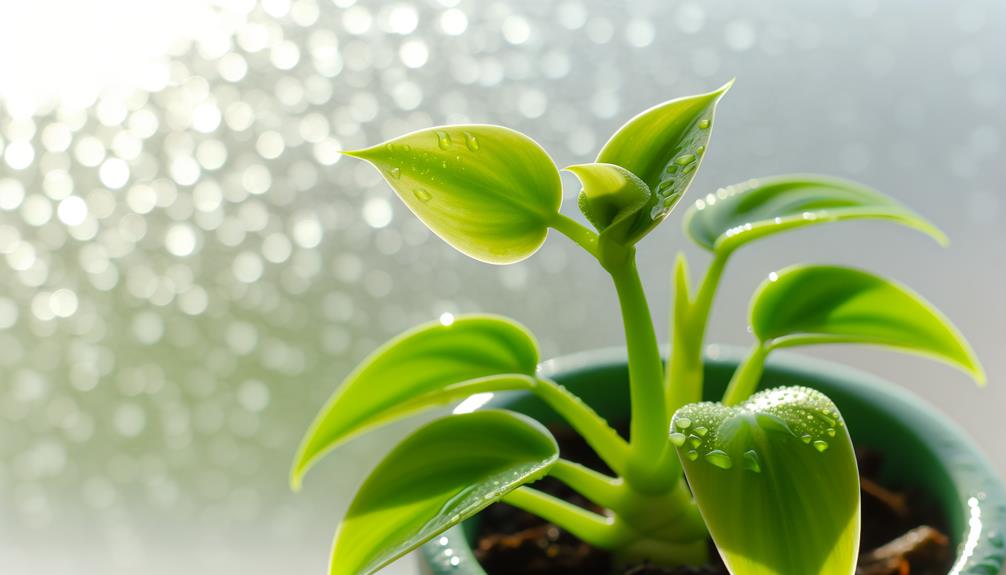
Perfect hydration is crucial for the health and development of a baby Philodendron Splendid, necessitating a careful balance to prevent both overwatering and underwatering. This tropical plant requires a consistent moisture level to thrive, but oversaturation can lead to root rot, while insufficient water can cause wilting and stunted growth.
Monitoring the plant's hydration needs involves several key practices:
- Soil Moisture Check: Regularly check the soil moisture by inserting a finger about an inch deep. Water when the top inch of soil feels arid.
- Watering Schedule: Establish a consistent watering schedule, typically every 7-10 days, adjusting for seasonal variations and indoor humidity levels.
- Drainage: Guarantee the pot has sufficient drainage holes to prevent water accumulation and promote healthy root aeration.
Accurate watering practices will support prime growth and vigor.
Soil Preferences
The Baby Philodendron Splendid thrives in a well-draining soil mix that prevents waterlogging and promotes healthy root development.
Incorporating organic matter is essential for nutrient availability and improved soil aeration.
The ideal pH range for this plant is slightly acidic to neutral, ideally between 5.5 and 7.0, to maximize nutrient uptake.
Well-Draining Soil Mix
A well-draining soil mix for a baby Philodendron Splendid should incorporate a balanced blend of organic material, such as peat moss or coconut coir, and inorganic components like perlite or orchid bark to facilitate proper aeration and moisture control. Securing the correct soil composition is important for promoting healthy root development and preventing issues like root rot. Consider these essential components:
- Peat Moss or Coconut Coir: Retains moisture while providing a light, airy structure.
- Perlite: Enhances drainage and aeration, preventing compaction.
- Orchid Bark: Adds texture and promotes airflow around the roots.
This combination ensures that the soil mix remains sufficiently hydrated yet prevents waterlogging, creating an ideal growing environment for the baby Philodendron Splendid.
Organic Matter Importance
Incorporating organic matter into the soil is important for providing essential nutrients and maintaining ideal moisture levels for a baby Philodendron Splendid.
Organic matter, such as compost, decomposed leaves, or peat moss, enhances soil structure, promoting aeration and root development. This supplementation increases the cation exchange capacity, enabling the soil to retain and supply crucial nutrients like nitrogen, phosphorus, and potassium.
Additionally, organic matter improves water retention while preventing waterlogging, creating a balanced moisture environment critical for the plant's growth. The gradual decomposition of organic material also fosters a rich microbial ecosystem, which further aids in nutrient cycling and plant health.
Integrating organic matter is necessary for the best development of a baby Philodendron Splendid.
Ideal Ph Levels
Understanding the best pH levels is equally important when ensuring the ideal soil conditions for a baby Philodendron Splendid. The best pH range for this plant is slightly acidic to neutral, typically between 5.5 and 7.0. Maintaining this pH range is essential for nutrient absorption and overall plant health.
Below are specific considerations for achieving the ideal pH balance:
- Soil Testing: Regularly test the soil pH using a reliable testing kit to monitor and adjust as necessary.
- Amendments: Incorporate organic amendments such as peat moss or compost to help maintain the desired pH.
- Water Quality: Use filtered or rainwater, as tap water can often alter soil pH due to its mineral content.
Ensuring these parameters supports strong growth and development.
Temperature Tolerance
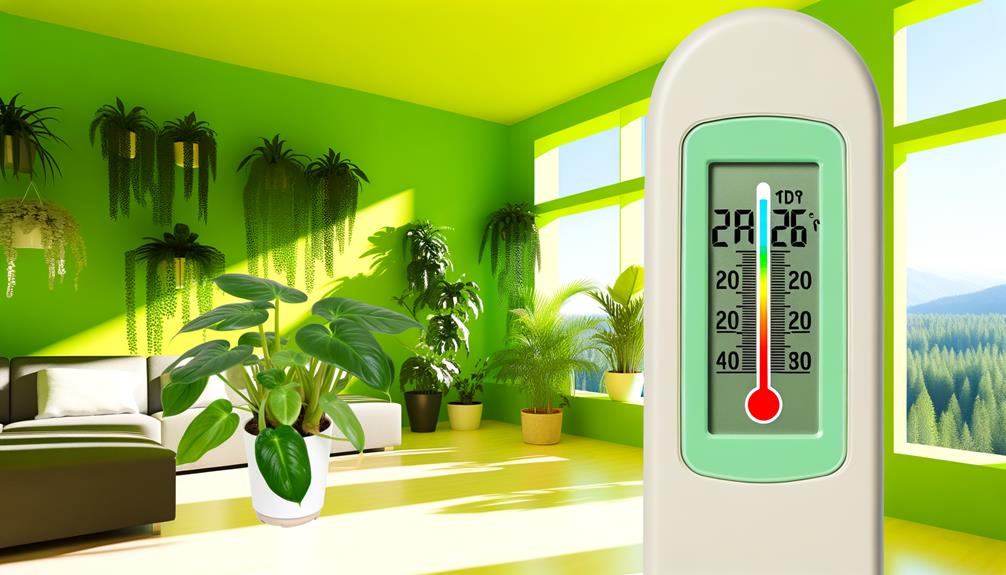
Philodendron Splendid exhibits growth at its peak within a temperature range of 65 to 80 degrees Fahrenheit, demonstrating sensitivity to both extreme heat and cold. This tropical plant thrives in stable, moderate temperatures, as fluctuations outside this range can hinder its development.
Exposure to temperatures below 55 degrees Fahrenheit can induce stress, leading to stunted growth and potential leaf damage. Conversely, prolonged exposure to temperatures exceeding 85 degrees Fahrenheit can result in dehydration and leaf scorch. Ensuring an environment with consistent, best temperatures is vital for maintaining the plant's health and vibrancy.
Sudden temperature changes should be avoided to prevent physiological stress, which can compromise the plant's overall liveliness and resilience.
Humidity Levels
Perfect moisture levels are crucial for the healthy development of Philodendron Splendid, with the plant flourishing in environments where relative humidity is maintained between 60% and 80%. This range supports peak physiological processes, including transpiration and nutrient uptake. Consistent humidity levels prevent dryness of the delicate foliage and promote strong growth.
To achieve and sustain these ideal conditions, consider the following:
- Humidifiers: Utilize a humidifier to maintain the air remains adequately moist, particularly in arid climates or during winter months when indoor air can become excessively dry.
- Grouping Plants: Place multiple plants together to create a microenvironment with higher humidity through collective transpiration.
- Misting: Regularly mist the leaves to provide immediate moisture, though this is a temporary solution and should complement other methods.
Pest Resistance
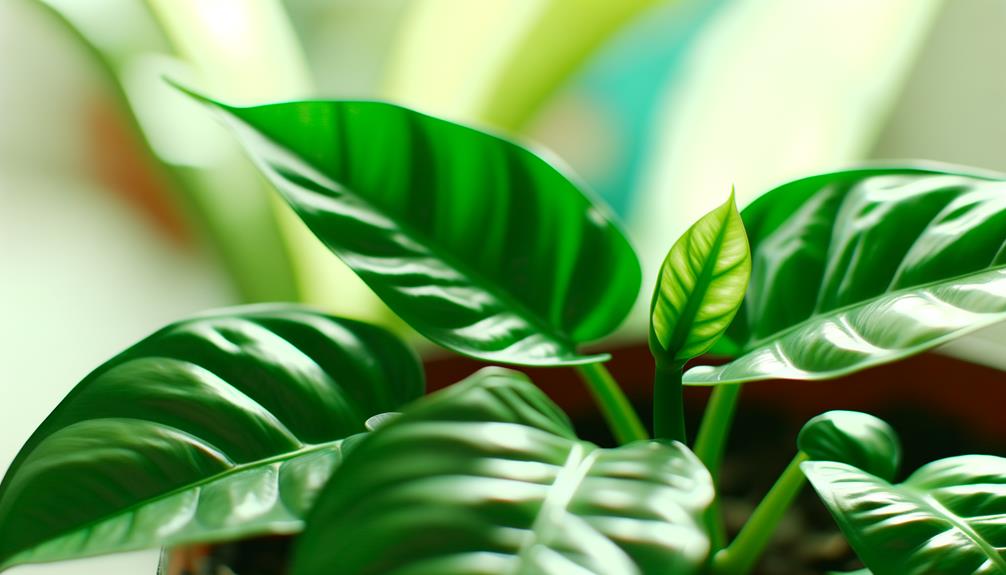
Despite its generally sturdy nature, the Philodendron Splendid may still fall victim to common pests such as spider mites, aphids, and mealybugs. These pests can cause significant harm by sucking sap, leading to weakened growth, chlorosis, and distorted leaves.
To mitigate infestations, regular inspection of the foliage is essential. Symptoms include fine webbing (spider mites), sticky honeydew secretion (aphids), and cotton-like masses (mealybugs).
Employing integrated pest management (IPM) strategies, such as introducing natural predators or using insecticidal soaps, can be effective. Additionally, maintaining ideal humidity and ensuring proper air circulation can deter pest colonization.
Early detection and intervention are key to preserving the health and aesthetic appeal of the Philodendron Splendid.
Propagation Methods
Asexual propagation of Philodendron Splendid can be effectively achieved through stem cuttings, guaranteeing genetic consistency and preserving desirable traits. This method involves several precise steps to maximize success rates:
- Selection of Cuttings: Choose healthy, mature stems with at least one node and a leaf. Nodes are crucial as they contain the meristematic tissue required for root development.
- Preparation: Cut the stem at a 45-degree angle using a sterilized blade to prevent infection. Remove any leaves near the base to avoid rot.
- Rooting Medium: Place the cutting in a well-draining medium, such as a mix of perlite and peat moss, and maintain high humidity to promote root formation.
These steps guarantee vigorous growth, effectively propagating Philodendron Splendid.
Conclusion
To sum up, the baby Philodendron splendid is a botanical marvel that displays unique leaf shapes, alluring color variations, and intricate veining patterns.
Its texture, size, and growth rate, along with its tolerance to temperature and humidity, make it a resilient plant.
The ease of propagation and resistance to pests further boost its attractiveness.
Like a jewel in a crown, this plant stands out, embodying both beauty and robustness, making it a valuable addition to any collection.

